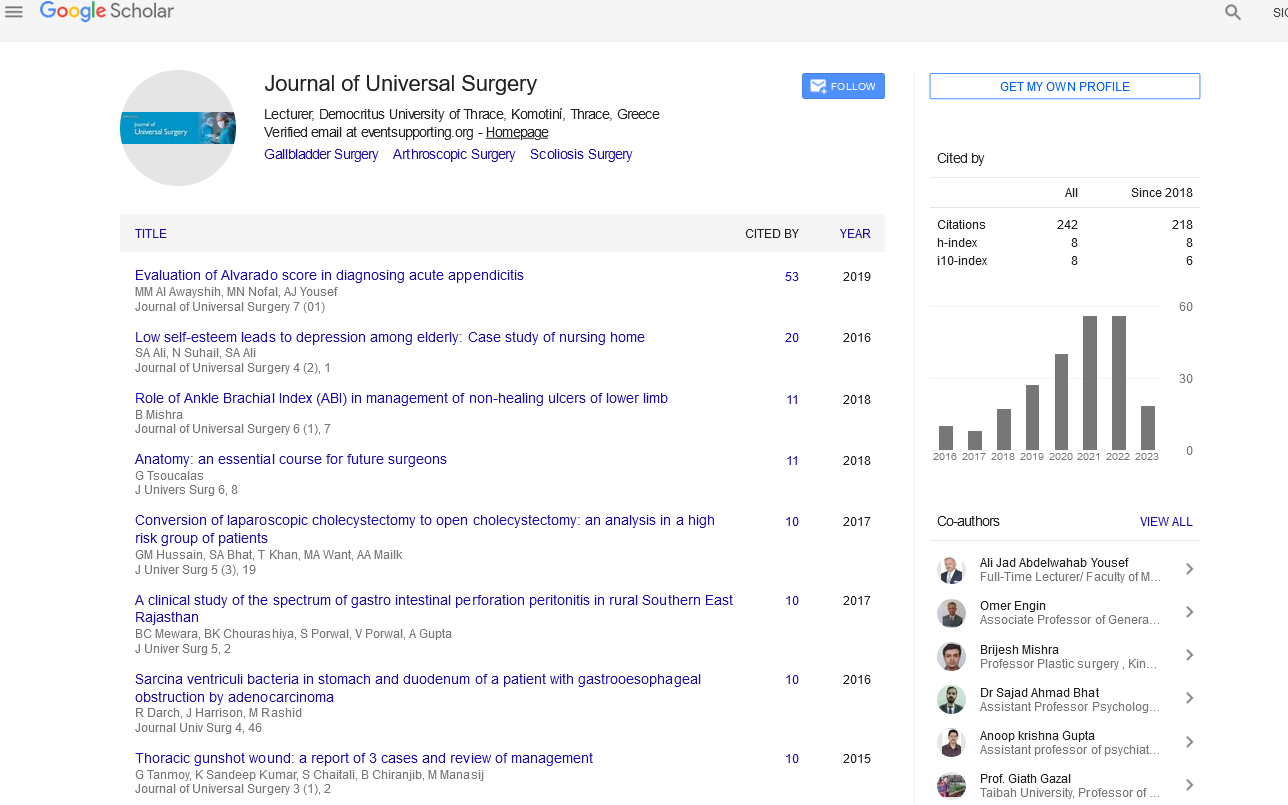Perspective - (2024) Volume 12, Issue 6
Hydrocele Surgery Necessity: Understanding When and Why It’s Required
Karim Zaveria*
Department of Urology, Gulmarg University, Gulamrg, India
*Correspondence:
Karim Zaveria, Department of Urology, Gulmarg University, Gulamrg,
India,
Email:
Received: 26-Nov-2024, Manuscript No. IPJUS-24-15369;
Editor assigned: 29-Nov-2024, Pre QC No. IPJUS-24-15369 (PQ);
Reviewed: 13-Dec-2024, QC No. IPJUS-24-15369;
Revised: 21-Dec-2024, Manuscript No. IPJUS-24-15369 (R);
Published:
29-Dec-2024
Introduction
Hydrocele, a condition characterized by the accumulation of
fluid in the scrotal sac surrounding the testicle, is generally
benign but can cause discomfort, swelling and in rare cases,
complications. While many hydroceles resolve spontaneously,
there are scenarios where surgical intervention becomes
necessary. This article explores the need for hydrocele surgery,
the benefits of treatment, and the factors influencing the
decision to operate.
Description
What is hydrocele
A hydrocele is a common urological condition, often painless,
that occurs when fluid collects around a testicle. It can affect
newborns, children, and adults. Hydroceles are broadly classified
into two types:
Congenital hydrocele: Common in infants, it results from the
failure of the processus vaginalis to close completely during
development.
Acquired hydrocele: Seen in adults, often caused by trauma,
infection, or underlying medical conditions.
Symptoms of hydrocele
Most hydroceles are asymptomatic, but symptoms can
include:
While these symptoms may not always necessitate immediate
treatment, they can significantly impact quality of life,
depending on the severity.
When is surgery necessary?
Hydrocele surgery, known as hydrocelectomy, is not always
the first line of treatment. The necessity of surgery depends on
several factors:
Persistent hydrocele in infants: Congenital hydroceles often
resolve within the first year of life as the processus vaginalis
naturally closes. If the condition persists beyond 12–18 months
or causes discomfort, surgery may be necessary to prevent
complications.
Significant discomfort or pain: Large hydroceles can lead to
significant discomfort, mobility restrictions or even
embarrassment. Surgery is considered when the discomfort
affects daily activities or sleep.
Underlying causes: If the hydrocele is secondary to infection
(e.g., epididymitis) or trauma, treating the underlying cause
might resolve the issue. However, if the hydrocele persists,
surgical intervention may be required.
Risk of infection or hernia: A hydrocele associated with an
inguinal hernia requires urgent surgical repair. Similarly,
hydroceles that become infected may necessitate surgery to
drain the fluid and prevent further complications.
Cosmetic concerns: While not a medical necessity, some
individuals opt for surgery due to cosmetic concerns, especially
if the hydrocele significantly alters the scrotal appearance.
Benefits of hydrocele surgery
Hydrocelectomy offers several advantages:
Immediate relief: Surgery eliminates the accumulated fluid,
providing immediate relief from swelling and discomfort.
Prevention of complications: It reduces the risk of infection,
testicular damage, or inguinal hernia.
Improved quality of life: Patients often report improved
confidence and mobility post-surgery.
Minimal recurrence: With modern surgical techniques, the
likelihood of hydrocele recurrence is very low.
Surgical techniques
Hydrocelectomy can be performed using different techniques,
depending on the patient’s condition and surgeon’s expertise:
Open surgery: The most common approach involves making
an incision in the scrotum or lower abdomen to drain the fluid
and remove or repair the sac.
Risks and complications
While hydrocele surgery is considered low-risk, potential
complications include:
Post-operative care, including rest, scrotal support, and
adherence to follow-up schedules, plays a crucial role in
minimizing these risks.
Alternatives to surgery
Not all hydroceles require immediate surgery. Alternatives
include:
Watchful waiting: Small, asymptomatic hydroceles in adults
or children often resolve on their own.
Medical management: Addressing underlying causes such as
infections can lead to resolution in secondary hydroceles.
Minimally invasive procedures: Aspiration and sclerotherapy
might be used as interim solutions for patients unfit for surgery.
The role of early diagnosis
Early diagnosis of a hydrocele is crucial in determining the
appropriate treatment pathway. Regular physical
examinations and ultrasound imaging can help differentiate
hydroceles from other scrotal conditions, such as varicoceles,
testicular torsion, or tumors.
Psychological impact of hydrocele surgery
In addition to physical symptoms, hydroceles can have
psychological impacts, particularly in adults. Persistent swelling may lead to embarrassment or social discomfort, especially in
intimate relationships. For such individuals, surgery not only
addresses the physical symptoms but also significantly improves
mental well-being.
Hydrocele surgery in special populations
Pediatric patients: Pediatric hydrocele surgery requires
specialized care, as the condition may involve associated
inguinal hernias.
Elderly patients: Surgery for hydroceles in elderly individuals
must be carefully planned, considering their overall health and
risk factors.
Conclusion
Hydrocele surgery becomes necessary when the condition
causes significant discomfort, persists beyond infancy, or poses a
risk of complications. While many hydroceles are harmless and
resolve on their own, surgical intervention offers a definitive
solution for symptomatic or persistent cases. Advances in
surgical techniques have made hydrocelectomy a safe and
effective procedure, ensuring relief and improved quality of life
for patients. For anyone experiencing symptoms or concerns
related to a hydrocele, seeking timely medical advice can help
determine the best course of action.
Citation: Zaveria K (2024) Hydrocele Surgery Necessity: Understanding When and Why it’s Required. J Univ Surg Vol.12 No.6: 052.





